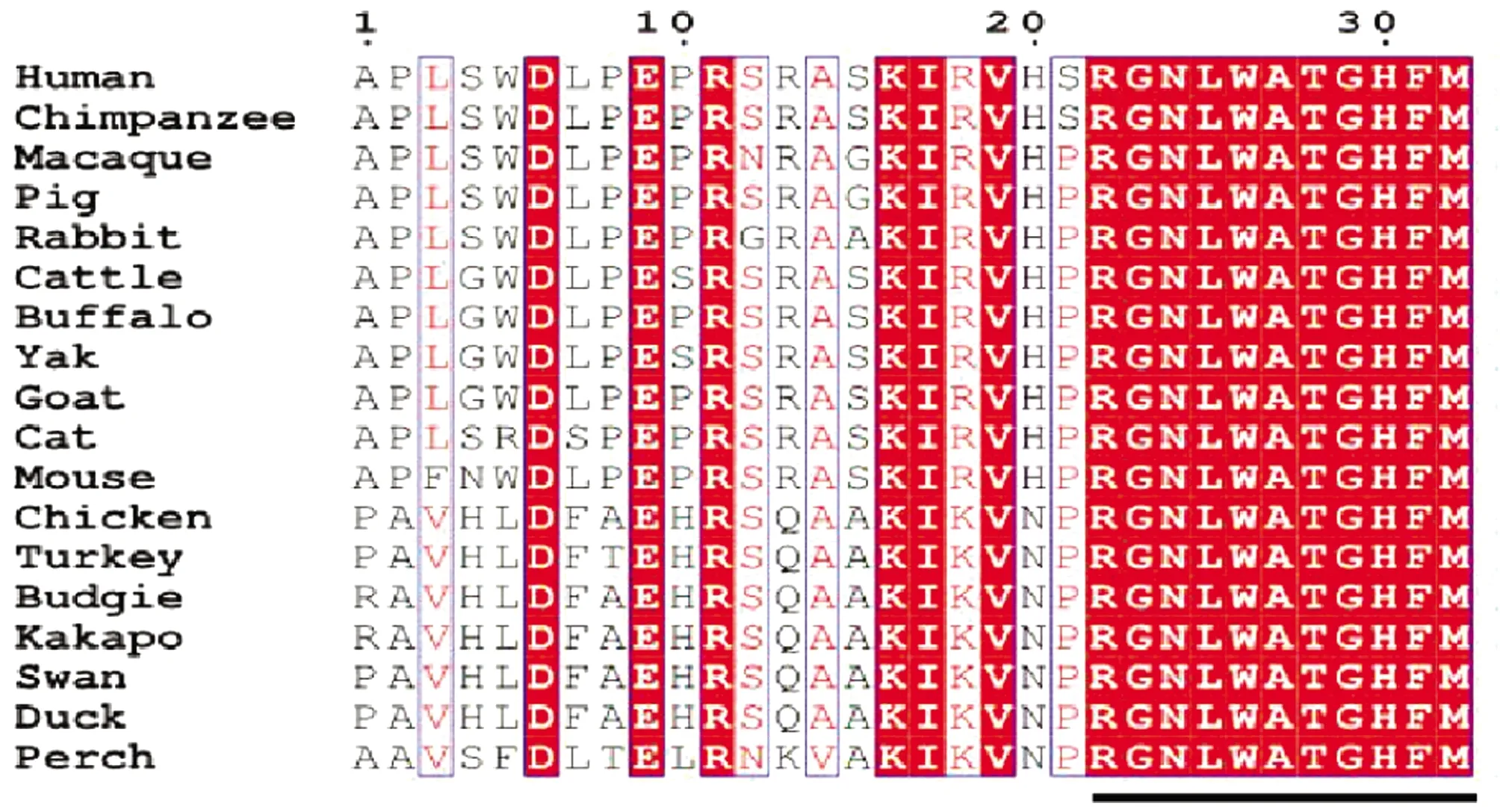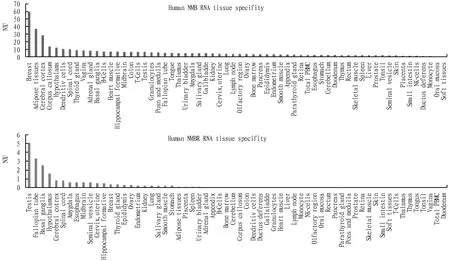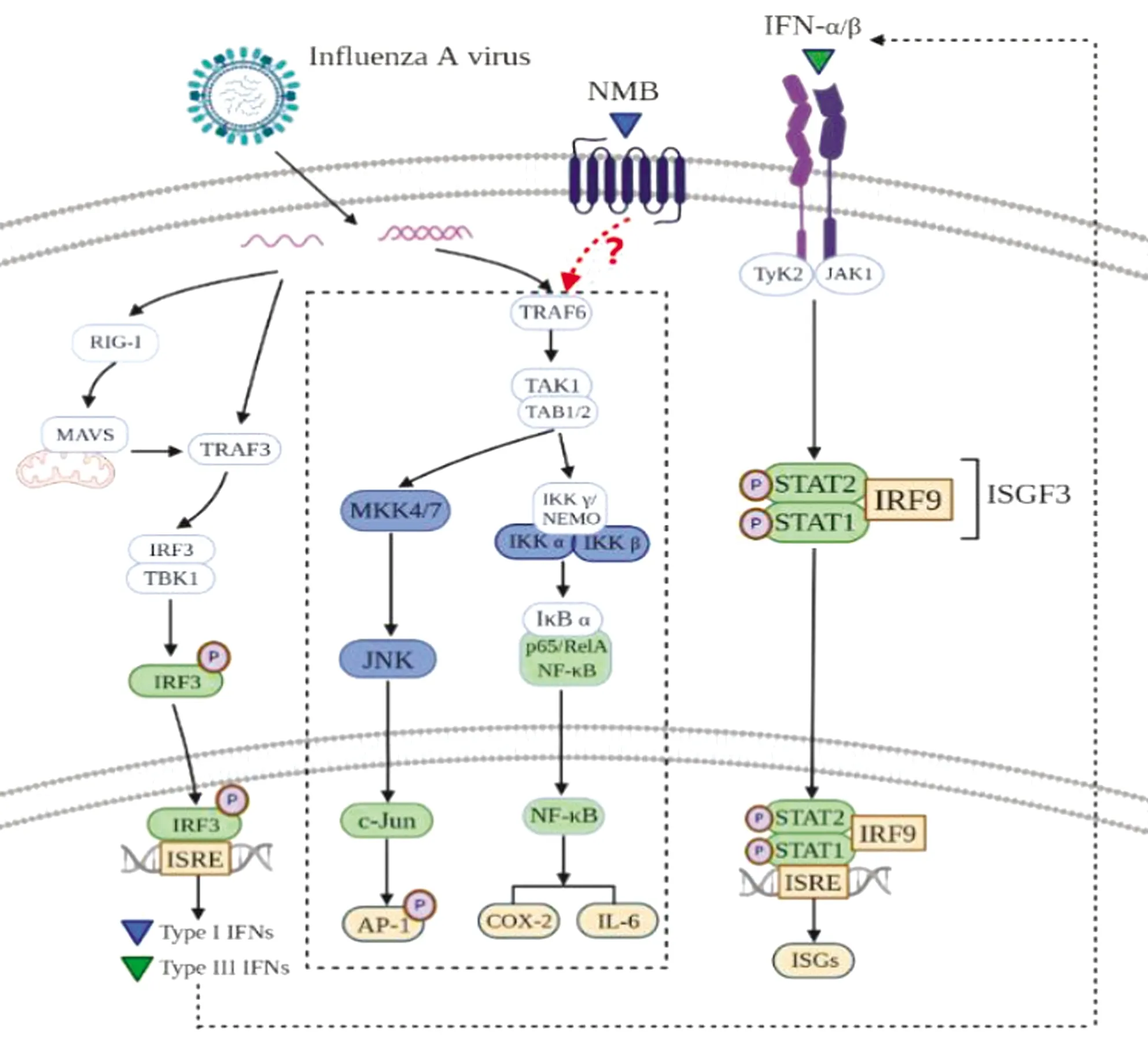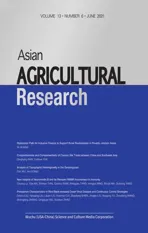New Insights of Neuromedin B and Its Receptor NMBR Involvement in Immunity
2021-08-24ChunyuLIYijieMAShimaoTIANQianhuiWANMengyaoTANGHongyaNINGShujieMAGuihongYANG
Chunyu LI, Yijie MA, Shimao TIAN, Qianhui WAN, Mengyao TANG, Hongya NING, Shujie MA, Guihong YANG*
1.Key Laboratory of Fujian-Taiwan Animal Pathogen Biology, College of Animal Sciences(College of Bee Science), Fujian Agriculture and Forestry University, Fuzhou 350002, China; 2.College of Animal Sciences(College of Bee Science), Fujian Agriculture and Forestry University, Fuzhou 350002, China
Abstract Neuromedin B(NMB)is a member of mammalian bombesin-like peptide family and almost all its potent biological actions take place exclusively through its receptor NMBR, which has been identified as a G-protein couple receptor with seven trans-membrane regions.NMB and NMBR represent an interesting signaling axis over which NMB/NMBR perform multiple biological activities, in particularly, they have been highlighted in the regulation of the immunology system.This review aims to provide a brief overview of the recent advancements in our understanding regarding the potential immunological functions of NMB and NMBR in cell proliferation, tumorigenesis, angiogenesis, neurogenic inflammation, anti-influenza A virus(IAV)infections, and briefly discusses the potential importance of these observations.All these implicated that targeting NMBR or developing analogues of NMB may represent a useful strategy for development of new anti-IAV agents.
Key words Neuromedin B/NMBR, Cell proliferation, Tumorigenesis, Angiogenesis, Neurogenic inflammation, Influenza A virus
1 Introduction
Neuromedin B is identified as the a member of the bombesin(BN)-like peptide family.This peptide was originally isolated from porcine spinal cord and digestive tracts, thus named NMB, and it is widely expressed in mammalian tissues and exists in at least 10, 32, and 30 amino acids of three isoforms.The decapeptide(NMB-10)was firstly identified and found to display potent contractile activity in a rat uterus in 1983.Then, the big NMBs, NMB-32 and NMB-30, were isolated from pig brain and spinal cord in 1985, and identified as N-terminally extended forms of NMB-10.NMB-32 consists of 32 amino acids, whereas NMB-30 was found to be a form of NMB-32 with two amino acids N-terminally deleted.At present, NMB has been cloned on various species of animals, such as human, chimpanzee, macaque, and pig.Comparing the molecular structure of NMB across different species, NMB’s amino acid sequence is found to be highly conserved; in particular, the C-terminal amidated sequence is highly conserved across several mammalian species and is crucial for binding its receptor, as displayed in Fig.1.

Note: Identical residues are shown in red shade, and the black underline indicates the conserved C-terminal amidated sequence.
The receptors for BN-like peptide family are divided into five subtypes, including BB1, BB2, BB3, BB4, and BB3.5, of which BB1 has the higher affinity for NMB than the other BN like peptides.Thus, BB-1 has been identified as NMB preferring receptor-NMBR; as an endogenous high affinity receptor of NMB.NMBR is atypical organ G protein-coupled receptor with 390 amino acids and seven trans-membrane regions.To date, NMBR has also been cloned on many species, and the amino acid sequences of NMBR are also well conserved across these species.
Several studies have characterized that both NMB and NMBR are widely expressed in the nervous system(NS)and peripheral tissues of humans and animals.In particular, the expression profiles of NMB RNA and NMBR RNA in humans could be obtained from an online database(https://www.proteinatlas.org/).As shown in Fig.2, expression of human NMB RNA was observed in 62 tissues and the RNA tissue specificity are including adipose tissue, brain and breast.However, NMBR RNA was only observed in 26 of 62 tissues and is enriched in the brain, fallopian tube, and testis.Notably, the expression of NMBR RNA was found in a number of tissues that contain NMB RNA, and these broad expression profiles of NMB may point to pleiotropic effects of this peptide.

Fig.2 Summaries of NMB RNA and NMBR RNA expression in human tissues [These pictures were made according to the online database(https://www.proteinatlas.org/)]
NMB binds to NMBR and subsequently results in the activation of multiple cellular responses, which are mostly mediated by phospholipase C(PLC), phospholipase D(PLD), NF-κB/P65 and AP-1signals,etc.
NMB and NMBR represent an interesting signaling axis called NMB/NMBR.Thein
vivo
andin
vitro
biological activities of NMB/NMBR have been investigated by taking the advantage of chemically synthesized compounds, recombinant peptides, as well as genetic editing techniques.NMB/NMBR has been mainly involved in a wide range of biological functions, such as food intake, energy metabolism, behavior, sensation, reproduction, the endocrine system, and cell growth.In addition, NMB/NMBR has also been implicated in immune response.As an important component of the neuro-endocrine-immune network(NEIN), NMB/NMBR has been confirmed to strongly counter PR8 infection in rats.Collectively, all of these functional tests indicated that NMB/NMBR has the potential pharmacological applications and the immune protective effects in clinical settings.Thus, the present review briefly discusses recent advancements regarding the potential functions of NMB/NMBR in immune regulation, and the potential importance of these observations.2 Involvement of NMB/NMBR in immune regulation
The neuro-endocrine-immune network(NEIN)maintains the stability of the internal environment in organisms and is implicated in host defense.As an important part of NEIN, neuropeptides could regulate innate and adaptive immunity through the signaling pathway of cyclic adenosine monophosphate-protein kinase A(cAMP-PKA)and induce the expression of related immune inflammatory factors, such as nuclear factor-κB(NF-κB)and mitogen-activated protein kinases(MAPKs).These suggest that the members of neuropeptide family may act as novel agents for treating inflammatory diseases.Neuromedin peptides are also associated with immunoregulation in animals, such as neromedin C(NMC), NMN, NMUand gastrin releasing peptide(GRP).Among them, GRP has been considered a mediator of inflammatory diseases and proposed as a potential anti-influenza drug.As a homologue of GRP, whether NMB could play the similar activities responding to inflammatory condition still needs further study.To further understand the function of NMB, genetic approaches have been used to create the NMBR-deficient mice.They showed a reduced response to the exogenous NMB, and down-regulated effect of NMB infusion on hypothermia, as well as decreased pain sensation.In addition, the functional tests have confirmed that NMB/NMBR could activate the signaling pathways of MEK/ERK1/2, PI3K/Akt and NF-κB, which are associated with the cell proliferation, tumorigenesis, angiogenesis, inflammation and anti-viral responses.
2.1 Cell proliferation
Several reports have characterized the stimulating effects of NMB on cell proliferation.For cell lines, the proliferating effects of NMB have been observed in C6 glioma cells(C6), ATDC5 cells, human normal colonic epithelial cells(NCM-460).It has been reported that C6 cells have a high affinity with NMB.NMB could promote the C6 cell proliferation by regulating the Caconcentration, arachidonic acid release, and c-fos gene expression in C6 cells.This action of NMB on the C6 cell proliferation has also been reversely confirmed through the inhibitory effects of NMBR antagonists(PD165929/PD168368/PD176252).Such stimulating effects of NMB on cell proliferation were also observed in ATDC5 and NCM-460 cells.For isolated primary cells, such an effect of NMB on proliferation was found in rat osteoblasts and pig leydig cells.A previous report showed that NMB could promote the DNA synthesis and activate the signaling pathway of ERK1/2MAPK in primary rat osteoblasts.Consistently, the positive regulation of NMB of osteoblasts proliferation was blocked by the pretreatment with NMBR antagonist BIM-23127.However, NMB had no significant effect on osteoblast differentiation.Another study found that only specific dose of NMB could stimulate the proliferation of leydig cells.All these studies indicated that NMB and NMBR are appeared to be important for the normal cell proliferation.2.2 Tumorigenesis
Various studies have also shown that NMB and NMBR affect the growth of a variety of tumors.The possible therapeutic potential has been well studied in the case of colon tumors, breast tumors and lung tumors.In colon cancer, it has been observed that both NMB and NMBR are expressed in the human normal colon epithelial cells(NCM-469)and malignant cells(Caco-2 and HT-29)lining the colon.These results suggest that NMB and NMBR are involved in the process of colon cancer, however, the specific role of NMB involved in colon cancer remains unclear and needs further study.In breast tumors, it has been shown that the over expression of NMBR protein in various types of breast cancer lines(MDA-MB-231, MDA-MB-468 and T47D)could regulate the growth of breast tumors under the treatment with PD168368.The results showed that PD168368 could inhibit colony formation and induce apoptosis in MDA-MB-231 cells, and inhibit human breast tumor in the xenograft mouse breast tumor model.Another study also revealed that NMBR is hypoxia-responsive in breast cancer cells.The hypoxia-inducible factor(HIF)is the essential determinant in angiogenesis and is also required for the growth of malignant tumors.HIF could directly influence the hypoxic induction of NMBR in breast cancers.NMBR signaling has also been cascaded in human non-small cell lung cancer(NSCLC)cells.It could activate the tyrosine phosphorylation of epidermal growth factor(EGF)receptor via generation of reactive oxygen species and metalloprotease activation.And, the activation of NMB on tyrosine phosphorylation in NSCLC cells were completely blockaded by the antagonsit of NMBR PD176252.These findings implicate a therapeutic value of NMBR for lung cancer.Although the exact mechanisms of the involvement of NMB/NMBR in colon cancer, breast cancer, and lung cancer have not been established at present, all of the above studies at least showed that the antagonist or other agents could disrupt NMB/NMBR signaling and may provide the important insights for the development of novel anti-tumor drugs.Thus, NMBR represents an useful target for the diagnosis and therapeutic strategies for different types of cancers.2.3 Angiogenesis
Angiogenesis is a crucial step in chronic inflammation and tumor growth.It has been well confirmed that many endogenous peptides could promote angiogenesis, and the expression of NMBR is strongly present in vascular endothelial cells, which may suggest that NMB could be involved in the process of angiogenesis.Thus, manyin
vivo
andin
vitro
experiments have been conducted in the attempt to reveal the physiological role of NMB in the process of angiogenesis.Previous reports demonstrated that NMB could not only increase the amount of microvascular sprouting in the adventitia of rat aortic rings in a dose-dependent manner, but also stimulate the chemotactic motility and tubular formation of human umbilical vein endothelial cells(HUVECs).The processes of endothelial angiogenesis were regulated by several important cellular signaling pathways, such as ERK and Akt/eNOS.Interestingly, it has also been previously observed that NMB could activate the phosphorylation of ERK, Akt, and eNOS, as well as promote the production of NO.Additionally, NMB strongly induced neovascularization in intact red blood cells and promoted hemoglobin production in mice.Te findings indicate that NMB could act as a potent angiogenic peptide.Accordingly, a report on the inhibitory effect of the NMBR antagonist PD1683689 showed that thein
vivo
andin
vitro
NMB-induced angiogenesis in breast cancer cells could be inhibited by PD1683689, which has been evidenced by the reduced levels of phosphorylation of ERK, Akt, and eNOS.These results of PD1683689 on angiogenesis further explained the pro-angiogenic action of NMB.Collectively, these studies showed that NMB could induce angiogenic activity at bothin
vivo
andin
vitro
levels, which further implicated that NMBR may propose as a potential target for treating the disorders of angiogenesis.2.4 Neurogenic inflammation
In the peripheral nerves, NMB was first demonstrated to be capable of inducing sensitization of peripheral neurons to thermal and mechanical stimulation.It has also been reported that NMB could restore the erectile function by stimulating the survival of nitrergic nerve in penis.Such a capability is typical in terms of its widespread roles in neurogenic inflammation.Previous observations showed that NMB could elicit local nociceptive reflex responses.And, NMB and transient receptor potential vanilloid 1(TRPV1)are co-expressed in the dorsal horn of the spinal cord and sensory neurons.TRPV1 has been identified as the marker of nociceptive neurons with an involvement in neurogenic inflammation.The expression of TRPV1 in many sensory vagal fibers co-expressing with interleukin 1 beta receptor(IL-1βR)could aid the NSin sensing inflammation in peripheral tissues by binding IL-1β, thus further activating the downstream anti-inflammatory pathway(Fig.3).This close association between NMB and TRPV1 suggests that NMB may also suppress inflammation induced by nociceptive responses via the vagal nerve reflex, although the central pathway circuits between NMB, TRPV1 and IL-1β receptor remains unclear.Together, these implicated that NMB/NMBR may be functionally involved in neural innate immune response.These studies collectively suggest that NMB may be a candidate molecule for treating the disorders in NS, particularly those affecting food intake, memory, stress and inflammation.
Fig.3 NMB co-expressed with transient receptor potential vanilloid 1(TRPV1)in vagal nerve neurons and implicated in neural control immune response pathway[54]
2.5 Anti-influenza A virus infections
NMB and NMBR participate in several physiological processes by regulating the activities of inflammatory factors.It has been well demonstrated that both NMB and NMBR can promote the expression of NF-κB and proto-oncogene Jun(Jun)and induce the phosphorylation of activated protein 1(AP-1), thereby further regulating the expression of cyclooxygenase 2(COX-2)and proinflammatory interleukin 6(IL-6)in human primary uterine myometrial cells.These observations confirmed that the NMB/NMBR axis is involved in labor onset, as it regulates inflammatory factors.Considering the close co-relationship between the NMB/NMBR signaling axis, inflammatory response, and cell proliferation, the involvement of NMB/NMBR in innate immunity against specific viral pathogens warrants further investigations.The neuropeptides exert anti-inflammatory effects via regulation of apoptosis and macrophage phagocytic activity, are closely associated with the inflammatory response caused by influenza virus infection, such as neuropeptide Y(NPY), GRP, and methionine enkephalin, and are directly involved in influenza virus infections.An increase in NPY expression was observed during influenza A virus(IAV)infection; however, the pathological changes in hosts improved after inhibiting NPY expression in pulmonary phagocytes.Notably, NMB could enhance the excitability of NPY neurons in the hypothalamic arcuate nucleus via autocrine pathways, and this indirectly implicated that NMB may play a specific role in response to IAV infections.While investigating the innate immune response induced by IAV infections, we have also observed that the expression levels of NMB and NMBR were significantly increased in hosts after PR8/H1N1 infection.These phenomena directly indicated that NMB and NMBR are involved in the process of PR8 infection.GPCRs have been involved in regulating almost all physiological processes and are important targets for drug development, which implies that NMBR may be a potential drug target.As expected, NMBR also shows a significant association with IAV infections.Our previous observation confirmed the anti-PR8 activity of NMBR in NMBR-deficient cells, which involves regulation of the expression of IL-6 and IFN-α,and the virus production.Possibly, the high expression level of IL-6 contributes to the pathogenesis of PR8 in NMBR-deficient cells, implying that NMB may also be a potential candidate for anti-IAV therapy.Consistently, the anti-IAV activity of NMB via the regulation of IL-6/IFN-α expression was also observed in mice.The lung pathological changes in mice caused by PR8 infection were significantly alleviated through NMB treatment.Additionally, our previous results showed that specific NMBR antagonist could almost completely reverse NMB-induced activities in the context of PR8 infections, thereby emphasizing the specific function of NMB in the innate immune response against PR8 infections.Although these observations could not explain the induction of NMB activity in NPY neurons, they at least provide novel evidence that NMB should be nominated as a new therapeutic target against IAV infections, similar to GRP.Strikingly, the regulation of NMB on the expression of IL-6 and IFN-α in response to PR8 infections seems to coincide with the signaling pathway of the host innate antiviral immunity as shown in Fig.4, which would provide new insights for investigating the potential anti-PR8 infection NMB/NMBR pathway.

Fig.4 The close association between the regulation of NMB/NMBR on the expression of IL-6/IFN-α responding to an influenza A virus(IAV)infection and the signaling pathway of host innate antiviral immunity implies an antiviral potential of the NMB/NMBR signaling pathway against IAV infection [This image was made using the open online tools(https://biorender.com/)]
3 Conclusions and further perspectives
This review presents the landmark studies of the involvement of NMB/NMBR in immune regulation through the activation of multiple cellular signaling pathways, thus highlighting the role of NMB/NMBR in host innate immune responses to IAV infections.NMB/NMBR has the potential to modulate various key pathways, like NF-κB, and PI3K/Akt, which are important for the regulation of IAV infection.Thus, targeting NMBR may represent a useful strategy for development of new anti-IAV agents.However, the mechanism of NMB/NMBR against IAV infection still remains unclear.More basic investigations are needed to further understand the action of NMB/NMBR in response to IAV infections.Apart from the need to conduct more basic studies, clinical trials have to be performed with the target to validate its anti-IAV therapeutic potential.These would provide a hope that NMB may emerge out as a novel agent for anti-IAV.
杂志排行
Asian Agricultural Research的其它文章
- Realization Path for Inclusive Finance to Support Rural Revitalization in Poverty-stricken Areas
- Competitiveness and Complementarity of Cocoon Silk Trade between China and Southeast Asia
- Analysis of Topographic Heterogeneity in the Sanjiangyuan
- Evaluation on Uncertainty of Detection Results of Aerobic Plate Count
- Analysis of Factors Influencing Residents’ Satisfaction with Pairing Aid Policy in Xinjiang: Based on the Data from Three Prefectures in Southern Xinjiang
- A Study on the "Quality" and "Quantity" of Financial Ecology in Henan Province
